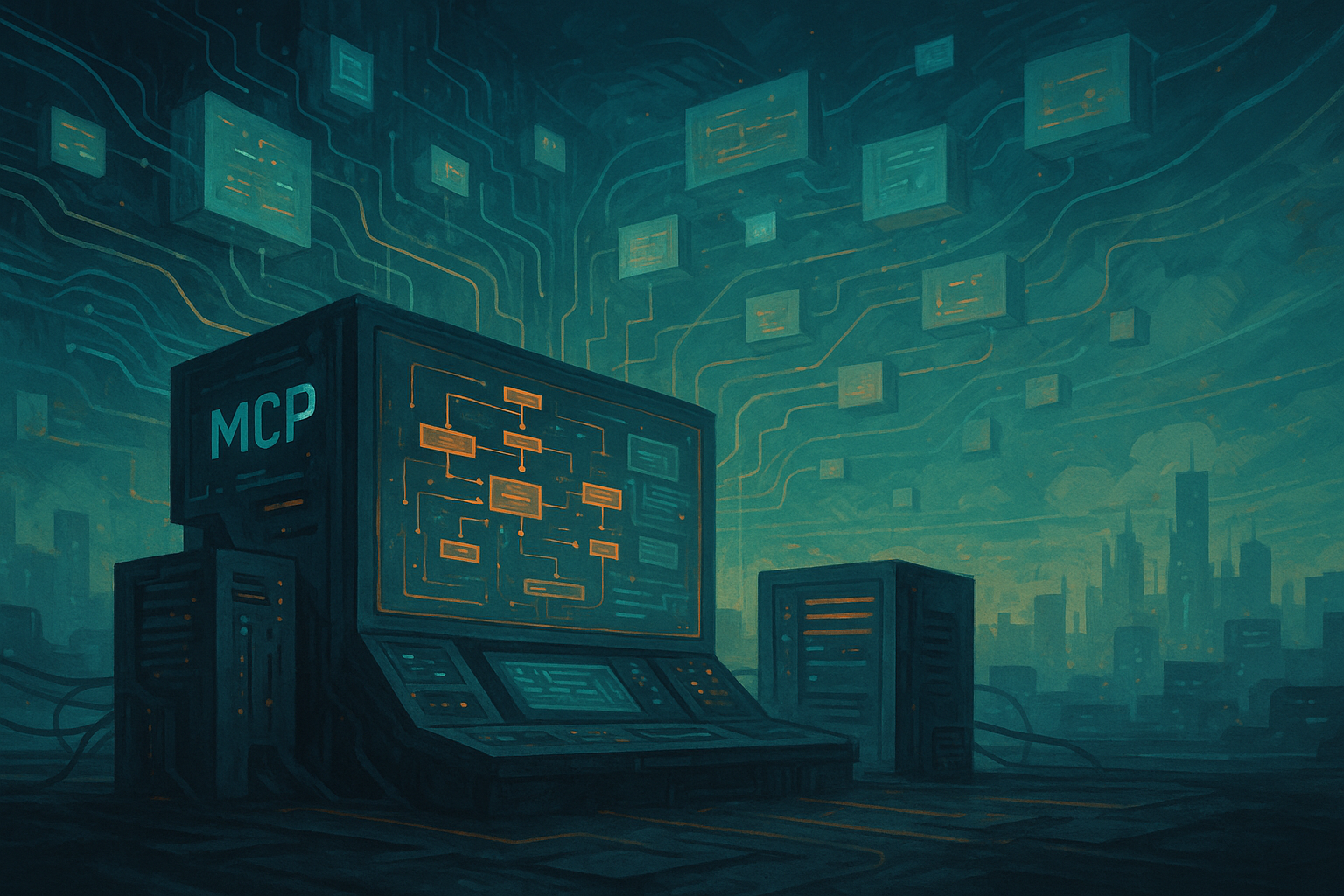Dynamic MCP: Guiding AI Agents Through Complex, Stateful Tasks
Discover how dynamically adapting tools and resources via the Model Context Protocol (MCP) can reliably steer AI agents through complex, multi-step workflows, preventing common pitfalls and boosting task success.

MCP Servers as Guides
The promise of AI agents – autonomous, tool-using entities that can tackle complex objectives – is captivating. Yet, anyone who has experimented with them knows the common frustration: agents often get lost. Faced with a multitude of potential actions or a long sequence of steps, they can make incorrect tool choices, lose context, or simply spin their wheels. Why is this, and how can we build more reliable AI partners?
Many current approaches to building AI agents involve providing them with a large, static set of tools and integrations. Imagine giving a novice chef access to every utensil and ingredient in a professional kitchen for their first complex recipe. The sheer number of options can be overwhelming, leading to mistakes or an inefficient process. Similarly, AI agents given a broad, unchanging set of capabilities can struggle to navigate the "action space" for tasks that require careful sequencing and context awareness.
But what if the environment itself could act as a "guiding hand"? What if, instead of presenting every possible tool at once, the system dynamically offered only the relevant capabilities and information based on the current step of a task? This is where the Model Context Protocol (MCP), when used dynamically, offers a powerful solution.
This article explores how MCP can move beyond being a simple API wrapper to become a mechanism for creating adaptive environments that actively guide AI agents through complex, stateful workflows. We'll illustrate this through a Number Guessing Game server, a seemingly simple demo that reveals profound principles for building more effective and reliable agentic AI.

The Power of Dynamics
At its core, the Model Context Protocol standardizes how AI models (or agents) interact with an external server. This includes discovering and calling Tools (actions the agent can perform), accessing Resources (contextual information), managing Sessions (for persistent interaction), and receiving Notifications (proactive updates from the server).
Many initial uses of MCP might involve creating a server that exposes a fixed set of tools that map to existing APIs – a "static MCP" implementation. This is valuable for standardization. However, the true potential of MCP is unlocked when the server becomes dynamic.
A dynamic MCP server actively curates and adapts the tools and resources presented to the agent based on the current state of the interaction or task. Instead of a static menu, the agent sees a context-aware set of options.
The benefits are significant:
- Reduced Action Space: The agent isn't overwhelmed. It sees only what's relevant now, minimizing confusion and the likelihood of selecting an inappropriate tool.
- Implicit State Management: The available tools and resources inherently signal the current phase of the task, offloading some state-tracking burden from the agent.
- Improved Task Completion: By narrowing focus and providing clear next steps, the agent is more likely to successfully navigate the workflow.
- More Natural Interaction: This mirrors how humans approach complex tasks – we focus on context-specific options rather than considering every possible action at every moment.
Our Number Guessing Game
Our demonstration project, an MCP server for a Number Guessing Game, might seem trivial. But its mechanics perfectly illustrate how a dynamic server guides an agent. Imagine an AI agent tasked with playing this game.
Here we work through the game manually and we can see the available tools changing as the game state changes.
Let's follow the agent's journey:
A. The Lobby - A Clear Starting Point
When the agent first connects and initializes an MCP session, it queries the server for available tools and resources.
- Server's Guidance: The server, knowing the game hasn't started (it's in a "Lobby" state), presents only one primary action: the
start_gametool. It also offers ahighscoresresource. There's noguess_numbertool yet – that would make no sense. - Agent's Experience: "Welcome to the game. My only sensible action is to 'start_game'."
B. Starting the Game - A State Transition and Capability Shift
The agent calls the start_game tool, providing its name. Internally, the server transitions from the "Lobby" state to the "Playing" state.
- Server's Guidance: This state change triggers a dynamic update to the agent's perceived environment. The server sends change notifications.
- The
start_gametool is now removed. - New tools,
guess_numberandgive_up, appear.
- The
- Agent's Experience: "The game has begun! The server has informed me that my available actions have changed. I can now 'guess_number' or 'give_up'."
C. Making a Guess - Adaptive Tooling and Contextual Feedback
The agent now calls the guess_number tool.
- Server's Guidance:
- Adaptive Tool Schema: If the agent guessed "50" and the server responds "Too low," the server doesn't just send a text message. It also updates the
guess_numbertool itself. The tool's input schema might now specify that theguessparameter must be between 51 and 100. The server sends atoolListChangednotification reflecting this. This is direct, actionable guidance embedded in the tool's definition. - Resource Content Update: The
game_stateresource is updated with the new feedback message ("Too low!") and the decremented attempts counter. The server sends aresourceUpdatednotification forgame_state.
- Adaptive Tool Schema: If the agent guessed "50" and the server responds "Too low," the server doesn't just send a text message. It also updates the
- Agent's Experience: "Okay, my guess was too low. The server has updated the 'game_state' resource with this feedback. Crucially, it also changed the 'guess_number' tool itself to only accept inputs in the new valid range. I don't have to parse the text message to infer the new range; the tool tells me directly."
D. Game End - Resetting the Stage
Whether the agent wins, loses, or gives up, the game ends. The server transitions back to the "Lobby" state.
- Server's Guidance: Again, change notifications are sent.
guess_numberandgive_uptools are removed.- The
game_stateresource is removed. - The
start_gametool reappears. - If the agent won, the
highscoresresource receives anresourceUpdatednotification.
- Agent's Experience: "The game is over. My available actions and information have reverted to the initial lobby state. I can choose to play again."
Throughout this process, the server isn't just a passive recipient of API calls. It's an active "conductor," dynamically shaping the agent's environment and available capabilities to guide it through the game's states. The agent isn't left to wonder if calling guess_number is valid in the lobby; the tool simply isn't there. It doesn't have to guess the valid number range; the tool's schema tells it.
Attaching the MCP server to the agent enables dynamic tool use. As the agent progresses through the game the available tools change accordingly.
Real-World Applications
This "guided" approach, demonstrated by our simple game, has profound implications for real-world AI applications that involve complex, stateful tasks:
- Interactive Software Onboarding: Imagine an AI guiding a new user through complex software. The MCP server could expose tools corresponding to UI elements. As the user completes a step (e.g., "Create Project"), the server dynamically updates the available tools to highlight the next logical actions ("Add Task," "Invite Collaborator"), effectively walking the user and the AI assistant through the workflow.
- Multi-Step Data Analysis Pipelines: An AI tasked with analyzing a dataset could be guided. Initially, tools for "Load Data" and "Inspect Data" are available. Once data is loaded (state change), tools for "Preprocess Data" (clean, transform) appear. After preprocessing, "Model Training" or "Visualization" tools become active. Resources would dynamically reflect the state of the data at each stage.
- Complex Configuration (e.g., Cloud Infrastructure): Setting up cloud infrastructure involves many dependent steps. An AI assistant could be guided: "Setup Network" tools appear first. Once the network (VPC, subnets) is configured (state change, confirmed by the server), tools for "Provision Compute Instances" or "Setup Database" become available, with parameters pre-filled or constrained based on the network configuration.
- Long-Running Autonomous Research: An agent tasked with researching a topic and writing a report could be managed through states like "Planning," "Information Gathering," "Drafting," and "Review." Each state would expose different tools (e.g., outlining tools, web search tools, document summarization tools, text editing tools) and resources (collected notes, draft sections, feedback). The server guides the agent through a structured research and writing process.
In each of these scenarios, the dynamic MCP server reduces the cognitive load on the AI agent, constrains its choices to relevant actions, and makes the successful completion of stateful tasks far more probable.
Implementation: Key Insights
Building such a dynamically guided experience requires a shift in how we think about MCP server design:
- Robust State Management: The server's ability to track and manage the current state of the interaction is paramount. Our demo uses a formal State pattern, but any reliable state mechanism will do.
- Clear Mapping of State to Capabilities: For each state, explicitly define:
- Which tools are available/active?
- Which tools are unavailable/disabled?
- Do any tool schemas need to change (e.g., input constraints)?
- Which resources are available?
- What content should those resources expose in this state?
- Proactive Notifications: Agents rely on change notifications to understand how their environment is changing. These must be sent reliably when the server adapts its offerings.
- Leverage SDKs: MCP SDKs handle the protocol's low-level details (message parsing, session management, notification delivery), allowing developers to concentrate on the dynamic application logic and state management.
- Think from the Agent's Perspective: Design the dynamic changes to be intuitive. Would an AI agent understand why its tools changed? Is the new set of tools clearly guiding it towards the next logical step in the task?

Conclusion
The initial promise of MCP was to standardize AI interactions. But its deeper potential lies in fostering a more dynamic, adaptive partnership between AI agents and the systems they interact with. Moving beyond using MCP servers as mere static API wrappers, we can create environments that actively guide agents, especially through the intricate pathways of stateful, multi-step tasks.
Our Number Guessing Game server, while simple, embodies this principle. It demonstrates that by dynamically curating an agent's available tools and contextual resources, we can significantly enhance its ability to navigate complexity, reduce errors, and ultimately perform more reliably. This "guided" approach is a key step towards realizing the vision of truly capable and autonomous AI agents.
We encourage you to explore the demo repository here to see this dynamic guidance in code. It's exciting to consider how these principles could be applied to other AI agent challenges, helping to move towards a future where AI and its environment work in a more intelligent, adaptive, and successful partnership.